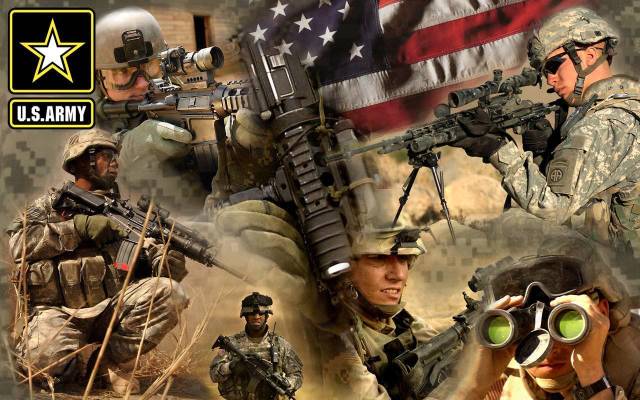The US Ground Forces, or the US Army (United States Army) are one of the main types and form the basis of the general-purpose forces of the country's Armed Forces . They are responsible for conducting ground operations independently or in cooperation with the Air Force and Navy, as part of joint operational formations in various theater of operations with the use of various means of destruction.
The mission of the US Army as a branch of the armed forces is to "fight and win wars ... of the country, ensuring rapid and sustained dominance on land in the entire spectrum of military operations and conflicts with the support of combatant commanders ." The formation participates in conflicts around the world and is the main ground offensive and defensive forces of the United States of America.
The US military forces are armed with a wide range of tanks and other armored combat vehicles, artillery, tactical missiles, military aviation and engineering equipment. The vast majority of weapons, military and special equipment are designed and manufactured in the United States.
Mission and tasks of the US Army
According to Section 7062 of the US Code, the purpose of the army is defined as follows:
- preserving peace and security and ensuring the defense of the United States, the Commonwealth of Nations and any territories occupied by the United States;
- support for national policy;
- implementation of national goals;
- fight against any states responsible for aggressive actions that endanger the peace and security of the United States.
In accordance with the current statutes and guidelines, the US Ground Forces solve the following tasks:
- continuous monitoring of the occupied territory;
- conducting long-term and continuous combat operations in various natural and climatic conditions, on difficult terrain and in populated areas;
- providing high firepower and maneuverability;
- effective opposition to enemy forces, especially its armored forces, and a limited threat from the air;
- suppression or destruction of enemy artillery;
- continuous conducting of intelligence and taking into account its results in their actions;
- reliable functioning of flexible, interoperable, mobile and closed communication and information systems;
- close cooperation with other components of the US Armed Forces and allies.
The Army Strategy 2018 formulates an addition to the Army Concept 2028. Although the mission of the army remains unchanged, its strategy is based on the modernization of brigades with special attention to the echelons of the corps and division level. The Army Futures Command oversees the reforms aimed at conducting a conventional war. The current reorganization plan of the US Army is scheduled to be completed by 2028 [supplemented for the period up to 2030].
The five core competencies of the army are: rapid and sustained ground combat operations; combined–arms operations (including combined-arms maneuver and security over a vast territory, armored, mechanized and airborne operations); actions of special operations forces aimed at creating and maintaining a theater of operations (theater of operations) of combined forces and the integration of national, multinational and joint forces on land.
As follows from the experience of armed conflicts in recent years, the share of participation of ground forces in the total number of forces involved in combat operations in the operations of the US Armed Forces varied from 66 to 98%.
The leadership and structure of the US Army
Senior leadership of the US Army[/b]
The body of the supreme leadership of the US Army is the Ministry (Department) of the Army (United States Department of the Army, DA). The Ministry is an agency of the federal government and one of the three military departments within the U.S. Department of Defense.
The headquarters of the Ministry (Pentagon, Virginia) – the supreme governing body of the US Army – consists of two divisions: the Office of the Secretary of the Army and the Army headquarters. These divisions, respectively, implement administrative and operational management functions. The Ministry of the Army is divided between its headquarters in the Government residence and the field structures of the army.

US Secretary of the Army Christine WORMUT
The Ministry of the Army is headed by a minister (SECARMY) – a civilian politician appointed by the President and approved by the US Senate. He is responsible for all the affairs of the Ministry, namely: presents and justifies the policies, plans, programs and budgets of the Army to the Secretary of Defense, other executive branch officials and Congressional defense committees. The Minister also informs the public about the policies, plans, programs, capabilities and achievements of the army. As necessary, he convenes meetings with the top leadership of the army to discuss issues and develop instructions.
The post of Minister of the Army since May 28, 2021 has been occupied by Christine Wormuth, the first woman in this position. The second official in the Ministry's office is the Deputy Minister of the Army.
The Army headquarters is headed by the Chief of Staff of the Army (CSA), a general appointed by the President of the United States for a four–year term. The Chief of Staff is the Chief Military Adviser and Deputy Minister of the Army. In a separate capacity, he is a member of the Joint Chiefs of Staff .
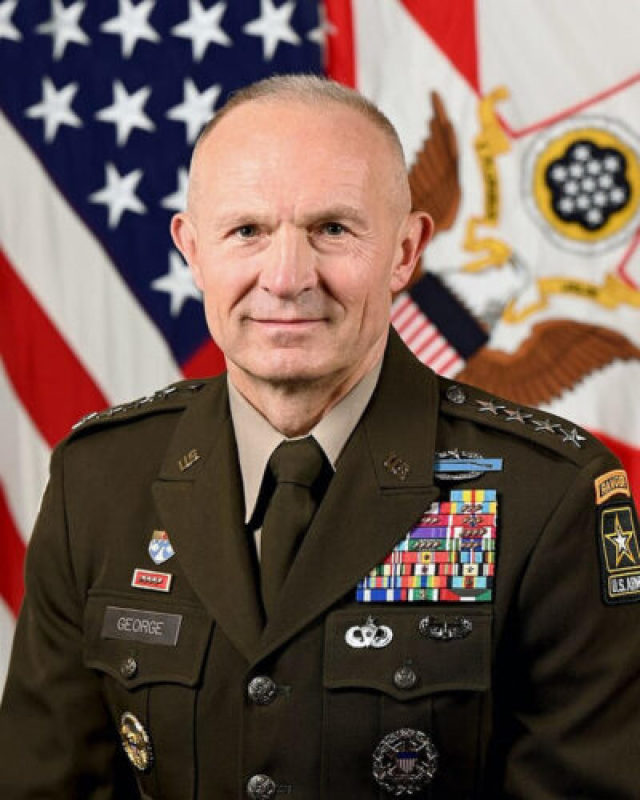
Acting NSH of the US Army General R. GEORGE
The Chief of Staff (NSH) does not have the authority of the operational command of the US Ground Forces proper (this is within the competence of combat commanders who report to the Secretary of Defense). He reports directly to the Minister of the Army and helps him in matters of compliance with army policy, plans and forecasts. As necessary, the NS gives instructions to the Inspector General of the Army to conduct inspections and investigations. In addition, the NSH heads the army headquarters and presents the capabilities, requirements, policies, plans and programs of the army in the relevant forums.
The Acting Chief of Staff of the U.S. Army since August 4, 2023 is General Randy A. George (Randy A. George).
In the structure of the Ministry of the Army, there are army commands (Army Command, ACOM) and commands of the components of the army service (Army Service Component Command, ASCC), designed for various purposes.
The first include: the Command of the U.S. Army Forces on the continental part (U.S. Army Forces Command, FORSCOM), the Command of the Future of the U.S. Army (U.S. Army Futures Command, AFC), the Command of the Material Support of the U.S. Army (U.S. Army Materiel Command, AMC), the Command for Training and Doctrine of the U.S. Army (U.S. Army Training and Doctrine Command, TRADOC).
The command of the components of the Army service includes 9 units, of which 6 are components of the Geographical Joint Combat Commands (CCMD), the others serve the functional commands of the US Armed Forces :
- U.S. Army Central Command (U.S. Army Central, ARCENT), Shaw Air Force Base, South Carolina;
- U.S. Army Europe and Africa Command (USAREUR-AF), Wiesbaden, Germany;
- Northern Command of the U.S. Army (U.S. Army North, ARNORTH), San Antonio, Texas;
- U.S. Army Pacific Command (U.S. Army Pacific. USARPAC), Fort Shafter, Hawaii;
- Southern Command of the U.S. Army (U.S. Army South, ARSOUTH), San Antonio, Texas;
- U.S. Army Special Operations Command (USASOC), Fort Bragg, S.C. Carolina;
- U.S. Army Cyber Command, (U.S. Army Cyber Command, ARCYBER), Fort Bellevore, Virginia;
- Ground Deployment and Dispersal Command (Military Surface Deployment and Distribution Command, SDDC), Illinois;
- U.S. Army Space and Missile Defense Command (USASMDC), Redstone Arsenal, Alabama.
Organizational and staff structure of the US Army[/b]
Currently, the US Ground Forces include three main components: the active – the Regular Army; and two reserve – the Army Reserve and the Army National Guard. Both reserve components mainly consist of part-time soldiers who are trained once a month. In addition, they conduct annual training sessions lasting from two to three weeks.
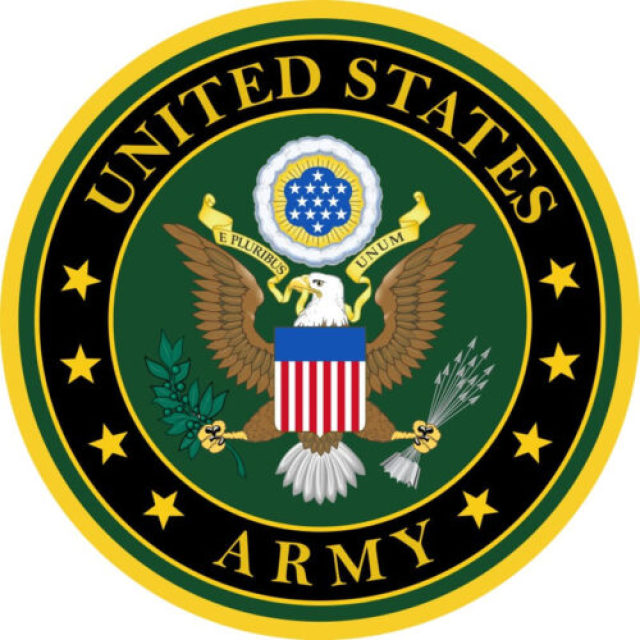
The US Army. Emblem
The Regular Army and the Army Reserve have an organization in accordance with Section 10 of the US Code. The organization of the SV National Guard is defined by Section 32. While The National Guard units are organized, trained and equipped as an integral part of the US Army, its individual units are under the command of the governors of individual states. However, by presidential decree, National Guard units may be transferred to federal control against the wishes of the Governor.
The total number of the US army and its reserve components, depending on the calculation method, varies from 1.4 to 3 million people, of which about 490 thousand people serve in the regular army.
The US Army consists of the branches of the armed forces and services.
Units and divisions of the branches of the armed forces directly conduct combat operations (infantry, armored troops, field and anti-aircraft artillery, army aviation, engineering troops, special operations combat formations) or perform combat support tasks (communications troops, military police, chemical troops, intelligence and counterintelligence units and units, psychological warfare formations).
Services (Adjutant General, artillery-technical, transport, quartermaster, etc.) include units and divisions that solve administrative, logistical and special support tasks.
A characteristic feature of the US Ground Forces is a relatively small number of combined arms formations with a significant total number of personnel. This is due to the presence of a large number of combat and logistics support units. The ratio of combat and rear components of the US Army in percentage terms is 52: 48.
More than a quarter of US Army soldiers are serving abroad. Like all other types of the US Armed Forces, the Ground Forces are recruited on a voluntary basis (for hire). At the same time, according to American legislation, with the introduction of a state of emergency in the country, it is possible to introduce the institution of military service.
Operational and staff structure of the US Army Currently, the following types of associations, formations and units are present in the US Ground Forces:
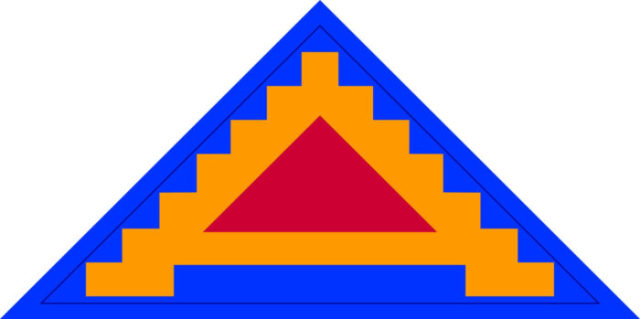
Emblem of the 7th Army OK of the US Armed Forces in the European zone
The Field Army – XXXX (Field Army) is basically an administrative structure consisting of several corps. Armies now also act as Army Service Component Commands (ASCCS) of the Joint Combat Commands, for example, the 7th Army OK of the US Armed Forces in the European Zone. The armies also effectively operated as military districts that previously existed on the continental United States. Currently, there are seven field army headquarters in the US Army. An army commander with the rank of general or lieutenant general.
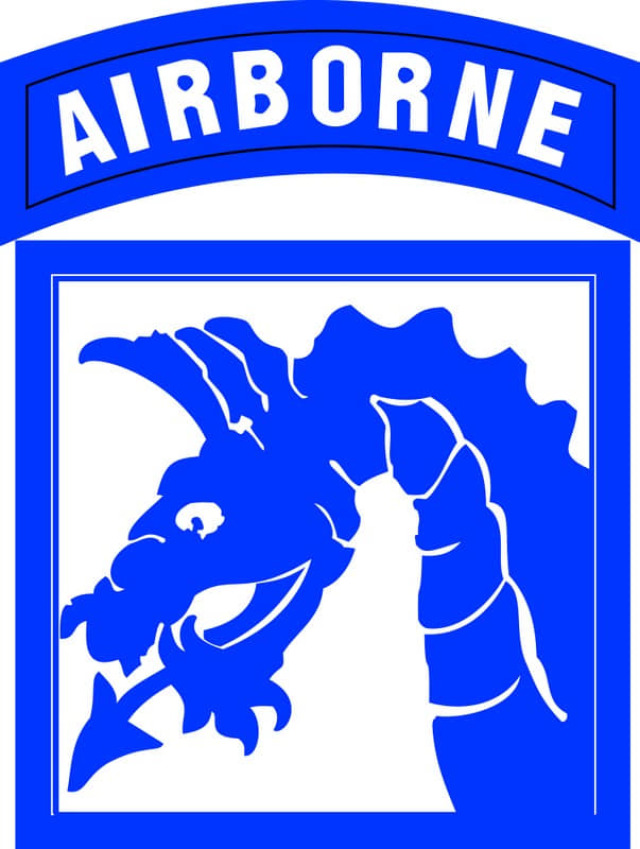
XVIII Airborne Corps. Emblem
Corps – XXX (Corps) – is designated as an "operational unit of application", combining a flexible number of modular units. Usually under the command of a lieutenant general. The number is 20-45 thousand military personnel. Today, the US Army consists of the 1st Army, 3rd Armored, 5th Army and 18th Airborne Corps
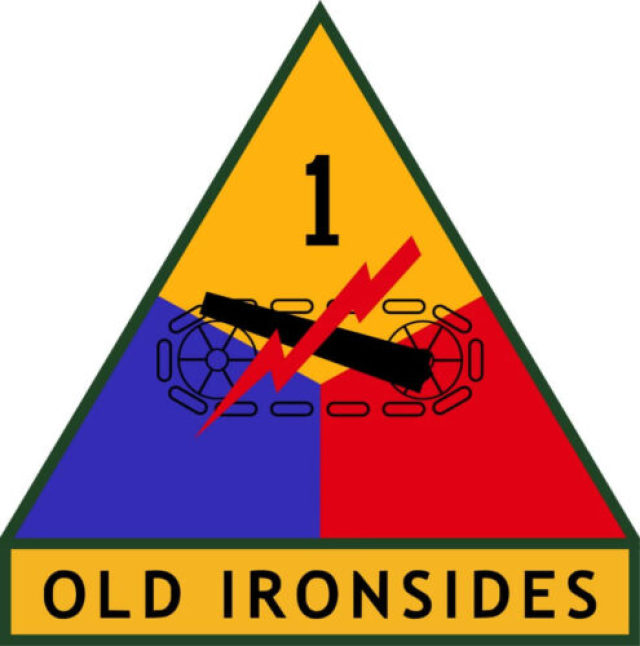
1st Armored Division. Emblem
Division - XX (Division) – Before the development of the concept of the "Brigade combat team" (brigade combat team, BCT), the division was considered as the smallest self-sufficient operational unit of the US Army. The current divisions have been transferred to a modular structure and can command a flexible number of modular brigades, but usually include three brigade combat teams and a combat aviation brigade, supported by a headquarters and a headquarters battalion. The division commander is usually a major general. the number of personnel varies in the range of 17 – 21 thousand people, but may increase to 35 – 40 thousand with attached support units. The regular army has 12 divisional headquarters, and the National Guard has 8 divisional headquarters.
Brigade – X (Brigade) – consists of three battalions. A commander with the rank of brigadier general or colonel, who is supported by the headquarters and the headquarters company. Modular brigades were transformed into brigade combat groups (BBG), usually consisting of three maneuver battalions, a cavalry squadron, a fire support division, a special-purpose battalion (with sappers, signalmen and military intelligence), as well as a senior command sergeant and a support battalion. The combat groups of the Stryker brigade have a slightly larger structure. The number of personnel from 3 to 5 thousand people .
According to open sources, in general, there are 10 armored BBGs, 7 Stryker BBGs, 7 light infantry BBGs and 7 airborne BBGs in the US Army.
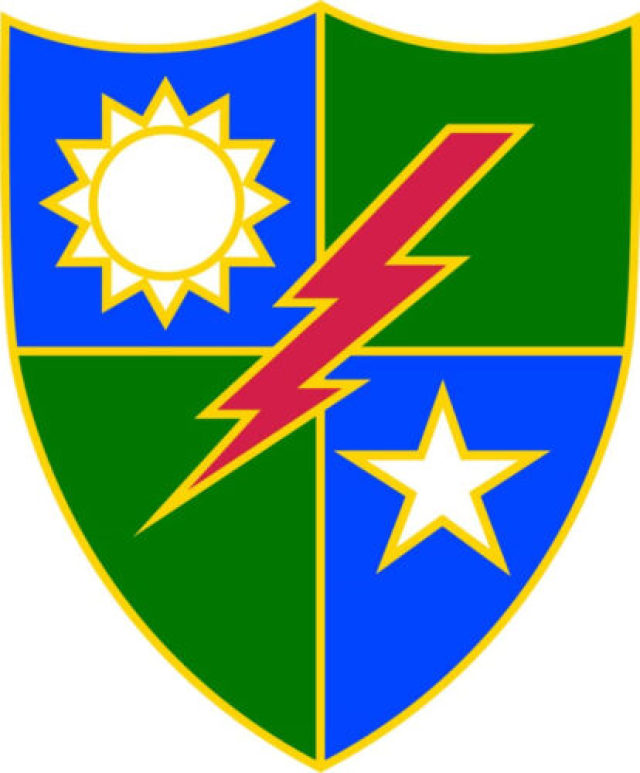
75th Ranger Regiment. Emblem
Regiment – ||| (Regiment) – the regimental structure in the US Army has been abolished, but remains in the designation of the historical affiliation of the battalions to the units of the regimental organization. At the same time, as an exception, a number of separate regimental-level units remain identical in composition to brigades: the 2nd and 3rd Cavalry regiments, the 11th Armored Cavalry Regiment, the 75th Ranger Regiment.
Battalion – || (Battalion) – by state has up to three (5-7 in separate battalions) companies (in artillery divisions of batteries), headquarters units, reconnaissance, communications and logistics units. The battalion commander is a lieutenant colonel. On average, the unit numbers from 800 to 1,500 personnel. Reconnaissance and cavalry battalions by origin are called squadrons (squadron).
Company / artillery battery / cavalry detachment – | (Company, Battery, Troop) – is denoted by Latin letters from A, B, C, etc., depending on the size of the superior unit. They consist of a headquarters and three platoons. The commander is a first lieutenant, captain or sometimes a major. The number is 62-190 soldiers.
Platoon – ··· (Platoon) – consists of a platoon headquarters and three squads (squad), headed by a second lieutenant commander. His deputy is a platoon sergeant (sergeant first class). The number of 42 people .
Section – ·· (Section) – is headed by a sergeant with the support of one or two corporals. It consists of squads and is often used in conjunction with platoons at the company level. 12-24 soldiers.
Squad – · (Squad) – consists of two groups (teams). Headed by a staff sergeant or sergeant. 9 soldiers.
Group – Æ (Team) – the smallest unit. The firing team includes a commander (sergeant or corporal), a gunner, a grenadier (with an under-barrel or hand grenade launcher) and a machine gunner. The sniper group consists of a sniper and a spotter. The number of up to 4 military personnel.
Based on open source materials
